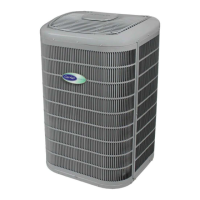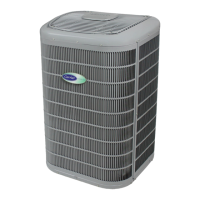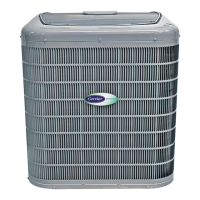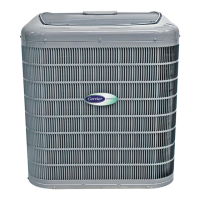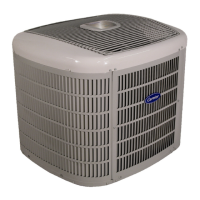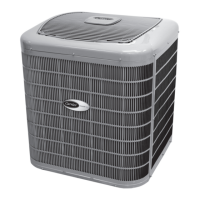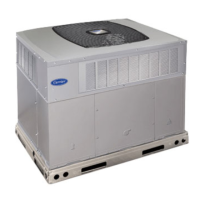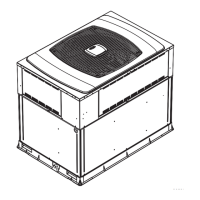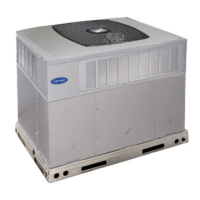24VNA6: Installation Instructions
Manufacturer reserves the right to change, at any time, specifications and designs without notice and without obligations.
16
If the outdoor air or coil thermistor should fail, the control will flash the
appropriate fault code (see Table 7.)
IMPORTANT: The outdoor air thermistor and coil thermistor should be
factory mounted in the final locations. Check to ensure thermistors are
mounted properly (See Fig. 28, Fig. 29 and Fig. 30).
Outdoor Air Thermistor
The outdoor air thermistor is a 10Kohm resistor used for multiple system
operations. It provides the outdoor air temperature to the primary
control module and user interface. It is essential for controlling the
system and is used in almost all modes of operation. The sensor is
mounted in the control box per Fig. 28.
A200045
Fig. 28 – Outdoor Air Thermistor Mounting Location
Outdoor Coil Thermistor
The outdoor coil thermistor is a 10Kohm resistor used for multiple
system operations. It provides the coil/liquid line temperature to the
primary control module and user interface. It is used for low ambient
operation and assistance with OAT temperature measurement. The
sensor must be securely mounted to the tube connecting the coil and
distributor. See Fig. 29 for proper placement. See Table 4 for proper
resistances.
A200046
Fig. 29 – Outdoor Coil Thermistor Mounted on Coil
Discharge Thermistor (ODT)
Discharge thermistor is used for protection against over temperature of
the compressor and the discharge superheat calculations. Proper
mounting is required to ensure that the unit exits the start-up mode. The
ODT is located on the compressor discharge stub-out (see Fig. 30).
A200086
Fig. 30 – Discharge Thermistor (ODT) Mounting Locations
Failed Thermistor Default Operation
Factory defaults have been provided in the event of failure of outdoor air
thermistor (OAT) and/or outdoor coil thermistor (OCT).
If the OAT sensor should fail the outdoor unit will operate at a fixed
speed.
If the OCT sensor should fail, the outdoor unit will operate at a fixed
speed.
Variable Speed Compressor Winding Resistance
This compressor operates with 3-phase variable frequency PWM
variable voltage. For troubleshooting certain fault codes related to
compressor resistances, follow these steps:
1. Disconnect compressor power leads from the inverter terminals,
U (YEL), V (RED), and W (BLK).
2. Measure the resistance between YEL to RED, YEL to BLK, and
RED to BLK and compare to Table 6 values. Each resistance set
should be equal.
3. Measure the resistance to ground for each lead.
4. If the resistances are correct then reconnect power leads to
appropriate terminal.
5. If the resistances appear to be abnormal, it will be necessary to
measure the resistance at the compressor fusite terminals.
6. Remove the sound blanket and harness plug, measure the
resistances, and compare to Table 6.
7. Reinstall compressor sound blanket making sure discharge
thermistor and compressor power harness are routed as they were
from the factory
Table 5 – ODT Resistance Values versus Temperatures
TEMPERATURE (°C) RESISTANCE (K OHMS)
25 50.15 + / - 5.0%
75 7.565 + / - 3.0%
125 1.7 + / - 1.4%
CAUTION
!
EQUIPMENT DAMAGE HAZARD
Failure to follow this caution may result in equipment damage and/or
improper operation.
In order to minimize the ambient influence, make sure the thermistor
curved surface hugs the pipe surface and is secured tight using the wire
tie fished through the original slot, insulating polymer body.
Table 6 – Variable Speed Compressor Resistances
(winding resistance at 68°F? (20°F)
WINDING 24 36 48 60
Between terminals T1, T2, and T3 .74 .453 .424 .424
Between terminal & ground >1 mega OHM

